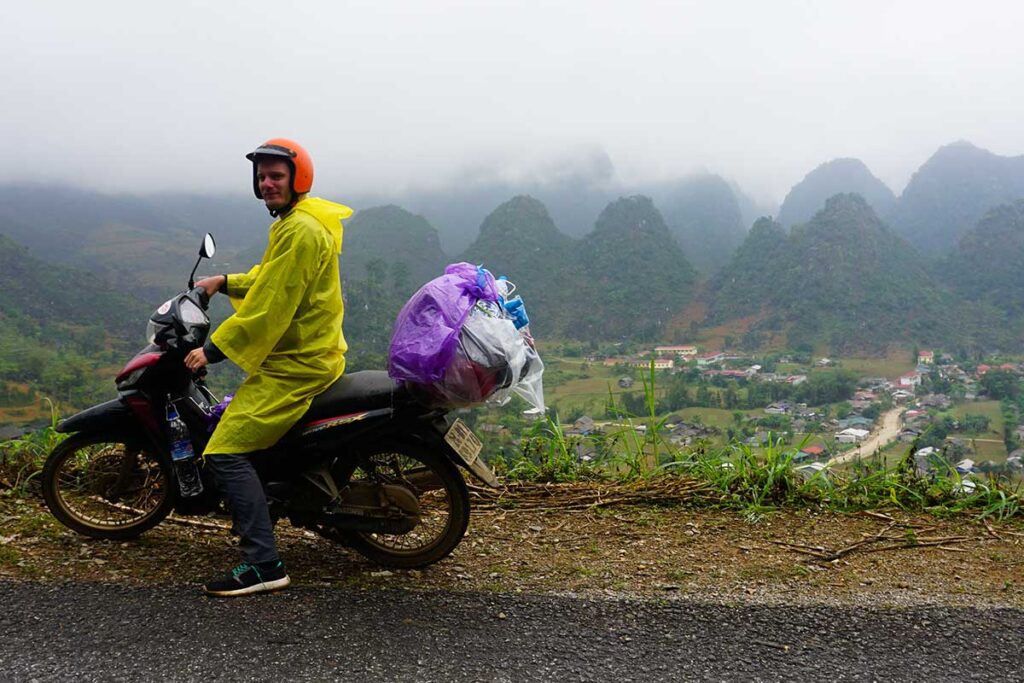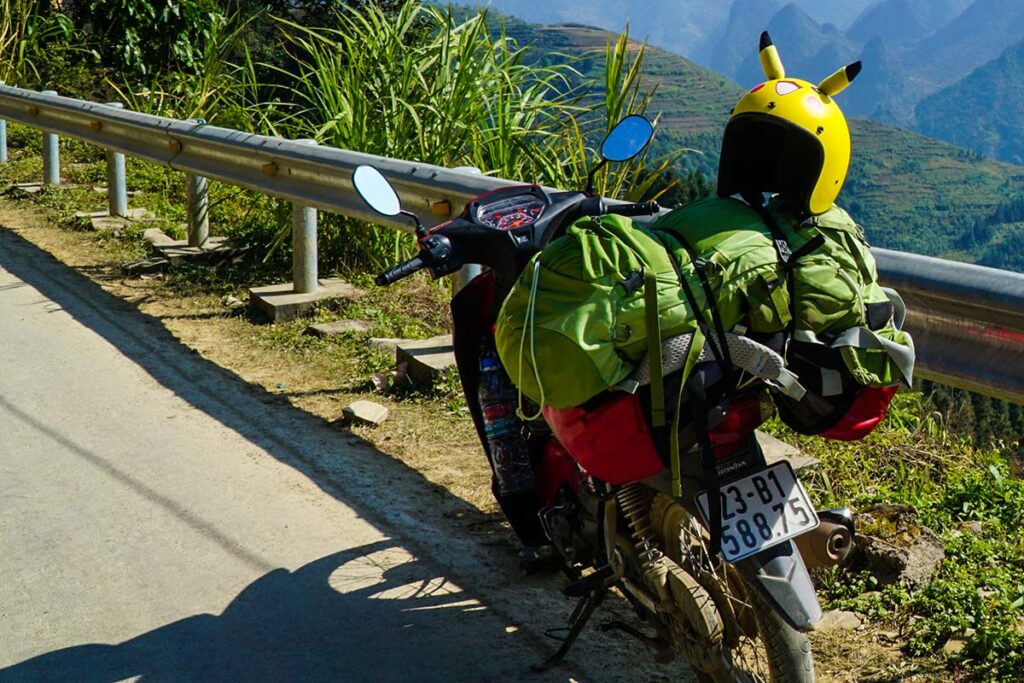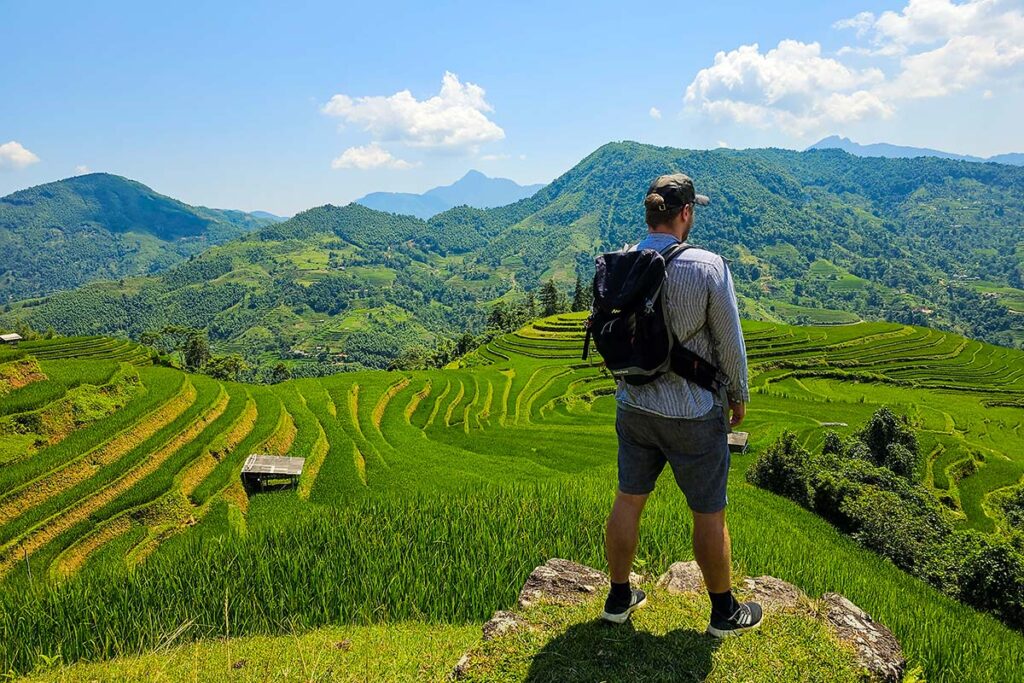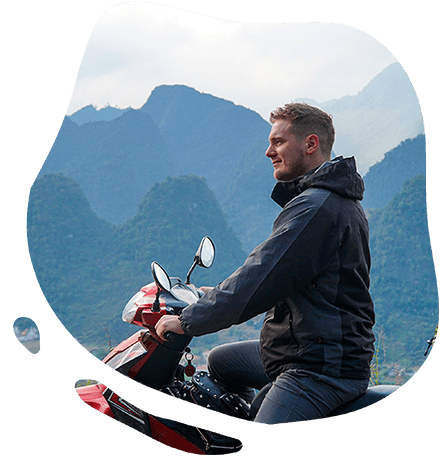Prepare for the Ha Giang Loop
Going on the Ha Giang Loop is an adventure worth preparing for, especially if you plan to explore it by motorbike. Being open to the elements and ensuring your safety requires extra preparation.
We’ve organized our tips into four categories:
- Clothes to pack
- General packing tips for all travelers
- What to bring on a motorbike for passengers and drivers
- Additional tips for motorbike drivers
Clothes to pack
May – September: During these months, expect hot weather with a chance of rain. It’s advisable to pack light and breathable clothes suitable for the heat. Additionally, bring a light rain jacket for rain showers and consider having extra clothes for when you get wet or sweaty.
October – November and March – April: These months offer moderate temperatures with less rain. It’s still a good idea to bring a light jacket as there is a possibility of rain or chilly weather when you are in the clouds on the mountains.
December – February: This period is mostly dry but can be cold, especially at night. Pack a jacket to protect yourself against the cold wind, and be prepared for the limited heating options in some homestays.
General packing tips
These tips are essential for anyone planning to embark on the Ha Giang Loop, whether traveling by car or motorbike.
1. Walking shoes
Throughout the Ha Giang loop, you’ll frequently find yourself taking short walks to explore villages, hike nature trails, or visit local markets. While flip flops may suffice for these short distances, it’s better to wear proper walking shoes for better comfort and safety. The roads can be wet, slippery, and uneven, with unpaved paths or even potholes, requiring sturdy footwear.
2. Toiletries and towel
Particularly when staying in remote and authentic homestays, it’s recommended to bring your own toiletries and a towel as they may not be provided. While hotels and more popular homestays usually offer these amenities.
Tips what to wear and bring on a motorbike
If you’re planning to explore the Ha Giang Loop on a motorbike, whether as a driver or passenger, these tips will help you prepare the necessary clothing and gear for a safe and enjoyable ride.
1. Protection
Without a doubt, the most important aspect of motorbike safety is wearing a good helmet that also provides protection for the sides of your face. When renting a motorbike or going by tour, these safety essentials should always be provided, and some companies may even offer additional gear such as knee and elbow protectors for enhanced safety.
2. Long clothes
While it may be tempting to dress in tank tops and shorts on a warm day, it is crucial to consider the potential risks in case of an accident where you might slide. Wearing long clothes not only provides protection in such situations but also guards against sunburn, which may go unnoticed during the ride.
3. Dress in layers
The weather can change quickly along the Ha Giang Loop, with moments of warm sunshine, sudden cloud cover, and even strenuous trekking that may leave you perspiring. Dressing in layers allows you to adapt to these changing conditions and ensures comfort throughout the trip.
4. A wind/rain jacket

As mentioned earlier, layering is key, so opting for a lightweight windbreaker or rain jacket is ideal to protect yourself against the cold wind, unexpected rain showers, and even chilly evenings when you want to spend time outdoors. Choosing a jacket that is not overly thick allows for easy packing.
5. Backpack

As there is limited space on a motorbike for large suitcases, it is advisable to opt for a smaller suitcase or backpack that can be easily secured behind the motorbike. Additionally, having a waterproof case is advantageous, although many rental companies provide large plastic bags to protect your belongings from rain.
6. Small day backpack

In addition to your main luggage, carrying a smaller day backpack is highly recommended for quick and easy access to essentials such as your camera, snacks, money, drinks, and other items you may need on the go. Since your main luggage will likely be securely strapped to the motorbike and possible has a rain cover, having a smaller backpack ensures convenience and easy retrieval of necessary items.
Additional tips what to prepare for driving a motorbike
Specifically designed for those who will be driving a motorbike themselves, these tips provide valuable insights to make sure you are safe and well prepared.
1. Closed shoes
In addition to the previous tips of wearing long clothes and protective gear, opting for closed shoes is highly recommended. Closed shoes offer better foot protection, enhance safety. Specifically, semi-automatic motorbikes have a foot-operated brake pedal instead of hand brakes. Closed shoes provide better foot support and grip, allowing you to comfortably and safely operate the foot brake when slowing down or coming to a stop.
2. (Sun) Glasses
Dusty roads are common in certain areas, and wearing glasses can significantly help in keeping your eyes protected and clear. Some helmets even come with built-in visors, and wearing proper sunglasses is beneficial, especially when the sun hangs low and affects your visibility on the road.
3. Phone and holder
If you are driving yourself, it can be nice to bring a phone holder with you, allowing you to securely mount your phone for easy navigation and accessibility on the road. Some motorbike rental companies even offer this accessory for rent.
4. Vietnamese Sim card
For uninterrupted access to navigation apps like Google Maps, convenient browsing on TripAdvisor for restaurant recommendations, and seamless communication using Google Translate with locals, it is essential to have a Vietnamese SIM card, especially since relying solely on Wi-Fi connections is not very handy when on a motorbike. Viettel is highly recommended for its extensive coverage throughout Ha Giang.
Extra tip: In remote areas where connectivity may be limited, consider downloading offline maps on Google Maps and offline languages on Google Translate to ensure you can access essential information even without an active internet connection.
5. Drivers license & IDP
If you plan to drive yourself, it is crucial to carry a valid driver’s license from your home country as well as an International Driving Permit (IDP). These documents are particularly important as police checkpoints are common along the Ha Giang Loop. Remember, IDPs can only be obtained in your home country, so make sure to apply for one before your trip to Vietnam.
6. Gloves
If you’re planning to drive a motorbike during the winter months of December to February, it’s highly recommended to wear gloves to keep your hands warm. Even during other seasons, gloves offer added protection while driving. They can protect your hands from wind, dust, and potential minor injuries.
What to do with all your luggage
If you’re traveling by car, it’s likely that you’ll have sufficient space to bring all your luggage with you. However, keep in mind that you’ll be staying in different accommodations along the loop, so it’s important to pack in a way that allows for easy carrying and organization of your belongings.
For those traveling by motorbike, it’s advisable to check the capacity and limitations of your bike before bringing too much luggage. Large suitcases can be challenging to transport on a motorbike, although it’s not uncommon in Vietnam to witness impressive feats of carrying capacity.
If you prefer to travel light and not bring all your belongings, you have two options. One option is to leave your luggage in Ha Giang. If you’re on an organized tour, the tour operator can assist you with this arrangement. Alternatively, you can consider leaving your luggage at the hotel in Hanoi where you stayed before embarking on your Ha Giang trip, provided that you plan to return there.
Hanoi serves as a major hub for exploring the northern regions of Vietnam, and many hotels offer secure storage facilities for guests who plan to leave for a few days and return.


